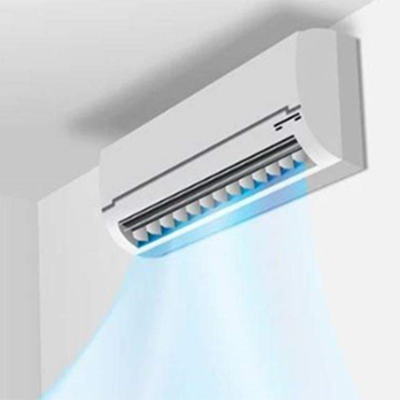Split AC System
The Split System model holds the Condenser and Compressor in an outdoor cabinet. Another indoor cabinet will hold the evaporator coil, and an air handler sends the cool air through the duct system. A line set – a copper tube that connects both the indoor and outdoor components – moves cold air to the house.
In a split system, the compressor condenses and circulates the refrigerant through the outdoor unit, changing it from a gas to a liquid. The liquid is then forced through the indoor evaporator coil or cooling compartment. The indoor unit fan circulates the inside air to pass across the evaporator fins. The evaporators metal fins exchange the thermal energy with the air around it.
From that point, the condenser or outdoor unit then turns the refrigerant vapor back into a liquid, removing any heat. By the time the fluid leaves the evaporator again, it is a cool, low-pressure gas, eventually returning to the condenser to begin its trip all over again. This process continues again and again until your home reaches the cooling temperature you want, as programmed and sensed by your thermostat setting. There, the refrigerant turns from liquid into vapor, removing any heat from the surrounding air. As the heat is removed from the air, the air is cooled and blown back into the house.
Key Application:
- Residential Complex
- Commercial Zones
- ATM Room
- HUB Rooms and Many More

Split AC System are basically required for the below purpose:
- Customizable – Because there are two components to a split system, placement is more flexible than a large HVAC packaged unit or Window AC
- Quiet Operation
- Split ACs blow more air and can cool more efficiently
- More Efficient – The SEER rating for split systems is typically 25 or above
- Value-adding – The energy efficiency of HVAC split systems is so high it has the potential to add resale value to your home
Advantages:
- Easy installation. The indoor unit can be up to 100 feet away from the outdoor condenser, yet the only space required is a small hole in a wall for the copper tubing and control wiring.
- Easy maintenance. Split air conditioning systems are easy to maintain. They have washable filters and require only routine cleaning periodically. Outdoor units are designed for easy access for maintenance and repair.
- Quiet operation. The indoor units of these systems are typically quiet enough for libraries, classrooms, boardrooms, and bedrooms.
- Heating capability. Most split air conditioning units provide “climate control” with additional heating as well, so you can live and work comfortably year-round.
- Cost effectiveness.
- Simple control. Most units come with a remote control, as well as a wall mounted thermostat, and temperature control is easy and convenient.
-
At NTIPL we pride ourselves on being a one stop shop that is able to meet all of our client’s needs. Our goal is to provide the highest quality design, deployment and installation services, on schedule, and in the budget along with outstanding customer service. We understand that time and cost are the main aspects so we strive to go above and beyond our client’s expectations.
For our customers peace of mind, we offer valuable money saving service and maintenance contracts on Split AC Systems.




